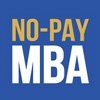by Laurie Pickard | Apr 27, 2015 | Courses, Platforms, and Profs, MOOC MBA Design

Nearly two years into my MOOC adventure, my enthusiasm for this learning technology hasn’t dampened in the slightest. Despite the fickle coverage of MOOCs in the press, with time I grow more - not less - excited about the changes they portend for higher education. I imagine we will look back on these early days of MOOC education and marvel at how far we’ve come.
Bill Aulet and Erdin Beshimov, of MITx’s popular Entrepreneurship 101 and 102 courses, agree with me.
I recently got the chance to speak with this dynamic duo, and I was pleased to find that they share my belief in MOOCs as a transformative technology. As Erdin Beshimov put it, “I’ve enjoyed the latest disenchantment with MOOCs quite a bit. It’s the best time to innovate. And I’ve come to believe that MOOCs are actually far more transformative than we had imagined in the beginning.”
Professor Aulet agrees.
“The people who don’t understand MOOCs are going to be left behind. It’s like when I first started in business, people said ‘I don’t need to do computers.’ Well think about it today. You cannot survive without using computers.”
One giant advance in the world of MOOCs was just announced last week. Starting next academic year, Arizona State University will now allow students to take their entire first year of university courses online via the MOOC platform edX. More on that in a minute. But there are other reasons to remain excited about MOOCs.
The four MOOC developments I’m most excited about
Online courses will become more interactive than IRL versions
One of the biggest complaints about MOOCs is that it is hard to pay attention and stay motivated in an online classroom. It’s too easy to try to multi-task; switch tabs on your browser, and within a few seconds you’re lost. But MOOCs are going to get better. Platforms like edX are logging millions of clicks to figure out what keeps students engaged and to develop new course content in accordance with those findings.
“It’s kind of like when movies first came out, they just made movies of plays,” Professor Aulet told me. “When MOOCs first came out they just took video of lectures. Now you’re starting to see the development of the tools, the assessment, and the exercises.”
Online courses certainly have the potential to be just as engaging - if not more so - than their classroom-based counterparts. Professors at Minerva, a startup university in California, have access to tools for the online classroom that allow them to track student engagement, call on people at random, assign groups, and deliver pop quizzes to assess comprehension. Even though Minerva’s first crop of students is physically together on campus, the online environment actually enhances the learning that is taking place rather than being an impediment to it.
This is also the goal that MOOC creators are striving towards. Says Erdin Beshimov, “What I think about on a daily basis is, how do I make our MOOC better than Bill’s on-campus course? It’s not an easy goal by any stretch of the imagination, but that’s what I’m doing. And I’m not the only one. Give it some time, but this mindset will take MOOCs from their uncertain beginnings to a very prominent position in education.”
Post-payment models will increase access to credentials and mitigate risk
EdX and Arizona State’s partnership to deliver the first year of university education online at a much-reduced cost is a ground-breaking development. What I find most exciting and innovative about this partnership is the fact that students won’t pay tuition until and unless they are successful at completing the courses. Admissions won’t be required; the courses will be accessible to anyone.
This model is similar to the model Udacity used in its partnership with Georgia Tech - no admissions; pay for certification only if successful.
I expect we will see more educational institutions adopting models like these, where the education itself is free and accessible and students pay for credit or a credential only after succeeding in the program.
Better networking possibilities
Over the course of my studies, I’ve watched MOOC communities form and grow. The community around Entrepreneurship 101 and 102 is especially large and vibrant, with over 150,000 people having taken at least one of these courses. For Erdin Beshimov and Bill Aulet, the community element is one of the most exciting things about teaching a MOOC. They emphasized that this community could be an important resource for entrepreneurs seeking co-founders. “Our MOOCs comprise a community of 150,000 people from every country in the world,” Beshimov explains. “This is just incredible. At some point, we’re going to become the biggest place to find future collaborators and co-founders.”
I can certainly attest to the power of MOOC communities for building startup ventures. My own network has expanded exponentially due to my public quest to replicate the MBA using MOOCs. To wit, I’ve pulled the majority of my startup team from among the ranks of people I’ve met through my courses.
I expect we’ll see even better networking possibilities emerge through MOOC-based communities. This is a goal I am working towards as a major component of the business I am launching.
MOOCs will be recognized as legitimate professional training
Much of the coverage of MOOCs has been about their potential effects on undergraduate education and college-age students - will universities will disappear or change? Can tuition fees and debt burdens can be lowered? Besides from lowering debt, MOOCs are poised to solve another problem in higher education - the mismatch between rapidly changing work requirements and an educational system that delivers most of one’s higher education in a lump before you’ve ever entered the workforce.
Luckily, this is a problem MOOCs are already capable of solving. I’ve used free online courses to shift my portfolio at work to be more private-sector oriented. My husband is taking courses to beef up his data analysis and program evaluation skills. Both of us already have master’s degrees, and both of us are finding MOOCs valuable on the job. I predict that before long, we will see more and more use of MOOCs as low-cost or free professional training.
Are you excited about MOOCs? Join the conversation! I’ll be on a Twitter chat with @MIT15390x on 29 April at 12 EST, and I’d love to see you there. Tweet with #MIT15390xChat.
by Laurie Pickard | Apr 18, 2015 | Career Development, Community and Networking, Most popular posts

I am what you might call a solopreneur, which Urban Dictionary defines as “an entrepreneur who works alone, ‘solo,’ running their business single-handedly. They might have contractors for hire, yet have full responsibility for the running of their business.” This describes No-Pay MBA to a tee. While I am in some ways a one-woman show, I have managed to assemble a team of consultants who are helping me get to launch day of what I’m calling No-Pay MBA 2.0.
One of the most exciting things about the No-Pay MBA project is its global nature. Almost every country in the world is represented among my readers. Likewise, those who have pre-registered for No-Pay MBAs come from every place imaginable - from Durban to Dallas, Mexico City to Mumbai.
My team is similarly global. Andrea is an American living in Rome, and she’s helping with social media and communications. Adam, a British guy living in Mexico, is on web development. If you take a look at some of his work, I think you’ll see why I’m so excited about what he’s doing to help me build the profile section of the new and improved No-Pay MBA website. Greg in Australia is helping with front-end layout and design; and Kevin Meldau, who is South African and living in Florida, is working on graphic design. He’s just created a new logo that I’m really excited about, and you can see other samples of his work here.
If you count both our places of birth and the countries in which we currently reside, this team of five represents seven countries. Only two of us are in the same time zone.
I’m studying management in my MOOC coursework, but working with this team to launch this business has also been a great experience in project management. I tend to enjoy the challenge of pulling together a great product on a tight deadline. Working with a geographically dispersed team has added a level of complexity to this endeavor that has forced me to up my game.
Below are some of the tools I’ve found helpful and some tips for managing a working relationship even when you’re miles apart.
Tools and tips for managing a global team
You are probably very familiar with the big dogs of remote teamwork - Google Drive and Dropbox for sharing documents, Skype and Hangout for communication.
But here are a few other free tools you may not be aware of.
Tools for working across time zones
World Time Buddy
World Time Buddy is a handy reference for scheduling when you’re in separate time zones. The free version allows you to compare three time zones.

Time Trade
I’ve just started using TimeTrade to schedule appointments. This helpful service allows me to specify when I’d like to schedule which type of appointments and allows clients to book time on my calendar themselves.
Google Calendar
And of course there’s that old standby Google Calendar. What you might not know about Google Calendar is that it automatically translates calendar invites into the recipient’s time zone.
Tools for managing work
Trello
Trello is a simple but powerful application for visual project management. It uses a system called Kanban, in which the project is mapped out using cards. The cards can be moved and rearranged to indicate level of priority and the stage each task is in. Adam and I are using Trello to collaborate on web development.
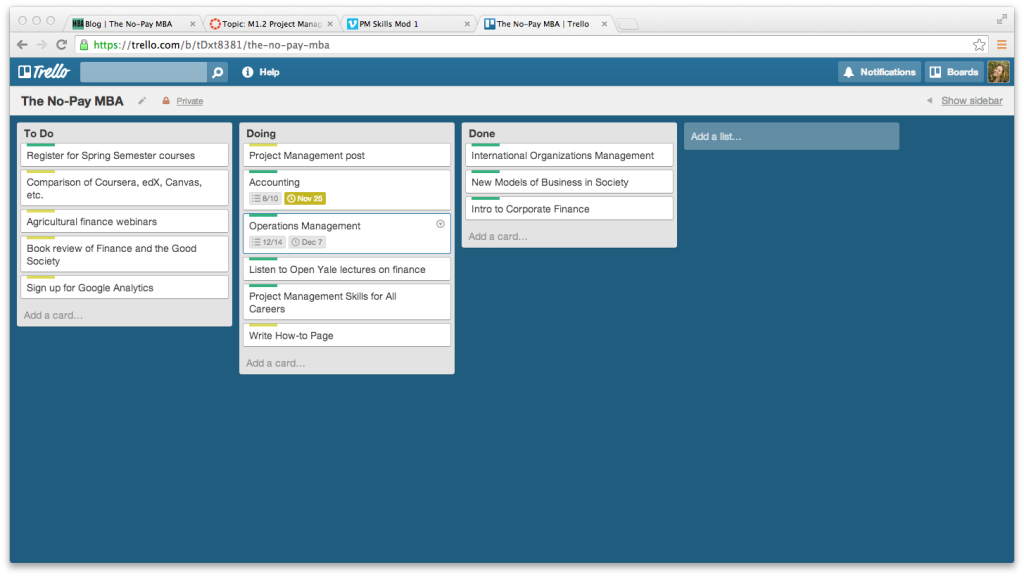
Gantt Charts
I’m a big fan of Gantt charts for mapping out and visualizing the project timeline. I like to create my own Gantt charts in Google Sheets and then add my team members as collaborators, but there are plenty of free web-based tools that can be used for the same purpose. The chart below shows how I’ve color coded various elements to indicate which person is taking the lead. This article has some great suggestions.
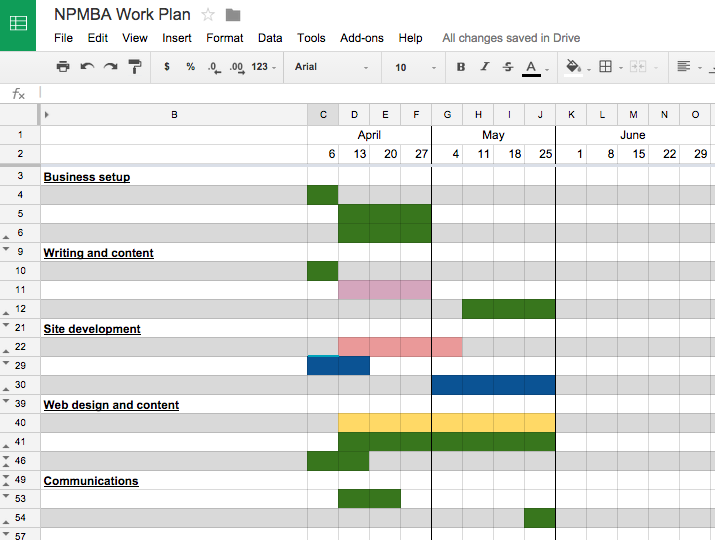
Tools for finding talent
ODesk
I used ODesk for the first time while assembling this team. If you haven’t heard of it, ODesk is one of several sites that act as a marketplace for freelancers to sell their services. These sites are all part of an emergent re-ordering of the workforce, which I find totally fascinating. If you’d like to better understand this new flexible work economy, The Economist had a great piece on the future of work a few months back.
Coursolve
Yes, I am a solopreneur, but I don’t plan to stay solo forever. I’m using Coursolve, a digital internship platform, for my long game. I recently posted a No-Pay MBA project to the site, which I hope will help me further hone my management skills and build my network of talent. If you’re interested, you can join my project here.
Tips on managing a global team
Peter Drucker, who is sometimes called “the father of modern management” is reputed to have said that “organizational culture eats strategy for breakfast.” While the true origin of this quote is up for some debate, its wisdom is generally accepted. Human relationships are the most important part of any business. Creating strong relationships can be more difficult when your team members are not physically in the same place, but it’s still just as important.
Use video, even when it’s awkward.
Don’t underestimate the importance of seeing the face of the person you’re working with. I do a lot of work via email, but a call every once in a while goes a long way towards establishing the kind of human connection that fosters a good working relationship. Even when my connection speed is giving me grief, I still like to at least start face to face in any online call. Whether or not I turn my camera off, this little bit of face time helps to establish a connection.
Make sure consultants see their part in the whole.
It’s important for anyone working on your project to understand where they fit into the big picture, how you plan to use their work, and why it is critical to the success of the project.
Be clear about expectations.
Especially when working with consultants who are not full-time employees, it’s important to make sure that both parties are in agreement about what work is to be done, what constitutes a successful outcome, and of course, compensation.
Tell your people you appreciate their work.
This is so important. Everyone needs to be recognized when they’ve done good work.
In that spirit, I’d like to close this post with a few shout-outs:
Andrea, thank you for being so organized and on top of things. You’ve cut my stress level tremendously and given me what feels like extra hours in the day to get things done.
Adam, thank you for your collaborative work style. I love that I am working with you on my site and that you’ve taken the time to understand my vision for it.
Greg, thank you for all your tips and pointers on SEO and for your great suggestions on design. I can’t wait to see what you come up with!
Kevin, I love your vision and your enthusiasm. Thank you for stepping up to fill a critical need at just the right time.
by Laurie Pickard | Apr 2, 2015 | MOOC MBA Design

As degrees go, the MBA is a generalist degree; the education is far broader than it is deep. Most MBA programs require a wide variety of core courses, covering everything from financial analysis and decision-making to operations management, marketing, and strategy. While a two-year program couldn’t possibly turn its graduates into experts in all of these areas, most programs do require their students to select an area of concentration in which they build expertise through coursework and assignments.
When I started my No-Pay MBA, I didn’t have a concentration in mind. Like many first-year MBA students, I went into the program with an open mind and a goal of getting a strong foundation of key business skills and concepts.
In order to cover the topic of entrepreneurship, one of the courses I took early in my business education was Steve Blank’s How to Build a Startup, from Udacity. From the first video lecture, I was hooked. Here was a way of thinking, solving problems, and helping people that was completely new to me - and totally captivating. Over the subsequent year, I developed an almost unintentional concentration in entrepreneurship; every time I become aware of an entrepreneurship course, I couldn’t help but register for it. I’ve taken courses on entrepreneurship in subsistence economies; a course called Beyond Silicon Valley: Entrepreneurship in Transitioning Economies; and I’m currently dual-enrolled in my fourth and fifth entrepreneurship courses – Entrepreneurship 101 and 102 from MIT’s Sloan School of Business.
If you’ve been reading the blog or any of the news coverage of this project, then you know that I am planning to launch a business supporting people who would like to use MOOCs to get an MBA education. Given the number of entrepreneurship course I’ve taken, and the fact that I’m now starting a business, it’s probably time to make it official:
My MBA concentration is in entrepreneurship.
If you join me in this project, I’ll provide plenty of recommendations on how to put together your own No-Pay MBA, including choosing and building a concentration. For those who are already studying business via MOOC, here are a few tips on how to fit a concentration into a MOOC-based MBA equivalent.
1. When starting your MBA studies, take a variety of courses. One of the great advantages of MOOC-based education is the low cost of changing your mind. Take full advantage of that freedom by not nailing down your entire course of study too early on. Whether you’ve budgeted 18 months or three years to finish your studies, the time to choose a concentration is in the second half of your program. It’s clear to me now that entrepreneurship is the right concentration for me, but I couldn’t have told you that at the outset of my studies; it was a process of discovery.
2. Aim to complete at least 4 courses in your concentration, preferably 5 or more. This may require some creativity and some timing, as not all courses are available at all times. For some fields of study you may need to look outside of the major MOOC platforms to find the content you need.
3. Don’t limit yourself to the traditional MBA concentration areas. Another great benefit of studying via MOOC is that you get to have full control over your curriculum. Traditional MBA programs offer a wide variety of concentrations to students. Some of the more common concentrations include corporate finance, marketing, strategy consulting, general management, and entrepreneurship. But no matter how many options a traditional MBA program gives you in terms of concentration, your MOOC-based program can be even more tailored, personal, and specific than even the most flexible of the traditional MBA programs. Choose a concentration that matches your career aspirations.
4. Do at least one real-world project - preferably more – that directly relates to your area of concentration and puts your skills to work. Even before I knew I would be concentrating on entrepreneurship, I did a digital internship for a startup called Coursolve. I worked with the company to develop their strategy for entry into a new market. My current real-world project - building my own business - is also in part a learning experience related to my concentration. The important thing is to get hands-on experience. Whatever you learn in the classroom, it’s how you are able to take that knowledge out into the real world that will determine the true value of your education.
by Laurie Pickard | Mar 8, 2015 | Courses, Platforms, and Profs, MOOC MBA Design
This morning, I re-read Kevin Carey’s New York Times op-ed on what it will take for MOOCs to lead to real changes in higher education. At the end of the piece Carey says that we won’t feel the full impact of MOOCs “until students and learners of all kinds have access to digital credentials that are built for the modern world. Then they’ll be able to acquire skills and get jobs for a fraction of what colleges cost today.”
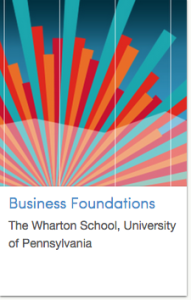 I totally agree with Kevin Carey, and I think that the new Coursera Business Foundations Specialization – along with the rest of Coursera’s Specializations and other so-called microcredentials (Udacity’s Nanodegrees, edX’s Xseries) - are a digital credential of the type that Carey describes. Whether they enable people to get jobs remains to be seen, but with the participation of Shazam and Snapdeal on the Business Foundations Specialization, this credential takes a giant step forward in that regard.
I totally agree with Kevin Carey, and I think that the new Coursera Business Foundations Specialization – along with the rest of Coursera’s Specializations and other so-called microcredentials (Udacity’s Nanodegrees, edX’s Xseries) - are a digital credential of the type that Carey describes. Whether they enable people to get jobs remains to be seen, but with the participation of Shazam and Snapdeal on the Business Foundations Specialization, this credential takes a giant step forward in that regard.
Coursera is my go-to MOOC platform . They have more business courses than anyone else, and the courses I’ve taken from them have all been excellent. In particular, the Wharton Business School courses (I’ve taken three so far) have been among my all-time favorites.
But I’m not planning on signing up for the Business Foundations Specialization. And here’s why not.
It’s not because of the price.
Yes, $595 is a lot more than free, and yes, Coursera used to offer Verified Statements of Accomplishment for these same courses at about half of what they cost in this Specialization. But $595 is also a lot less than $25,000, which is what you would pay for the first semester of business school alone. I also appreciate that Coursera has kept the course material free, even while charging a fee to those who want the certificate, which covers not just the four courses but also a capstone project.
I don’t have any problem with paying for certificates or course content; the No-Pay MBA is not an ideological stance. I consider myself extremely lucky to have been able to take all of my courses for free thus far, but if I find I have to pay to get the content I need, I won’t think twice as long as the price is reasonable. As a business student, I also understand the need for the MOOC platforms to find a sustainable business model.
It’s not because I can’t get credit for the Wharton courses I’ve already taken, though if you paid for a Verified Statement of Accomplishment you can.
Changes in the course length and content are disappointing.
I didn’t realize that there was anything different between these courses and previous versions of the Wharton Foundation Series courses, until a reader pointed out to me that all of the new courses are only four weeks long. The previous versions were up to ten weeks, just like regular university courses. The reader who alerted me of this change also pointed me to a discussion board where students lamented the changes to Wharton’s Introduction to Accounting.
The professor of Intro to Accounting, Brian Bushee had a different take on the changes. He told me by email:
“For many students, four weeks will be enough. For the rest, the remaining six weeks of my old course will be available as an additional course. A nice feature of splitting the course in half like this is that students can take the second six weeks at any future point. They no longer have to commit to a ten-week block. With this added flexibility, I expect that more students will now be able to take the full ten weeks of material.”
I understand Professor Bushee’s point, but as a student I appreciated the fact that in Introduction to Accounting – and the other Wharton courses – I got most if not all of the content of the regular, on-campus course. But even that wouldn’t necessarily stop me from registering for the Specialization, especially given that the additional content is still available.
For certain people the Business Foundations Specialization could be the right digital certification.
If you’re planning to apply to Wharton or another business school having this Specialization under your belt could be a leg up. Or maybe you just need an introductory understanding of business and want a certificate to demonstrate that you’ve attained it.
The credential I need goes beyond Business Foundations.
I’d be happy to pay a few hundred dollars for a digital credential if I thought it could provide additional legitimacy to my studies or could materially advance my career. But given that my project is to do a whole MBA with MOOCs – on a very small budget – this particular certificate doesn’t offer enough value for the money, especially given that the content is not as robust as it once was.
Others who are studying business via MOOC, I’d be interested to hear your thoughts on the Business Foundations Specialization. Are you planning to register? Why or why not? Comments welcome.
by Laurie Pickard | Feb 28, 2015 | MOOC MBA Design, Thoughts on Higher Ed and Life
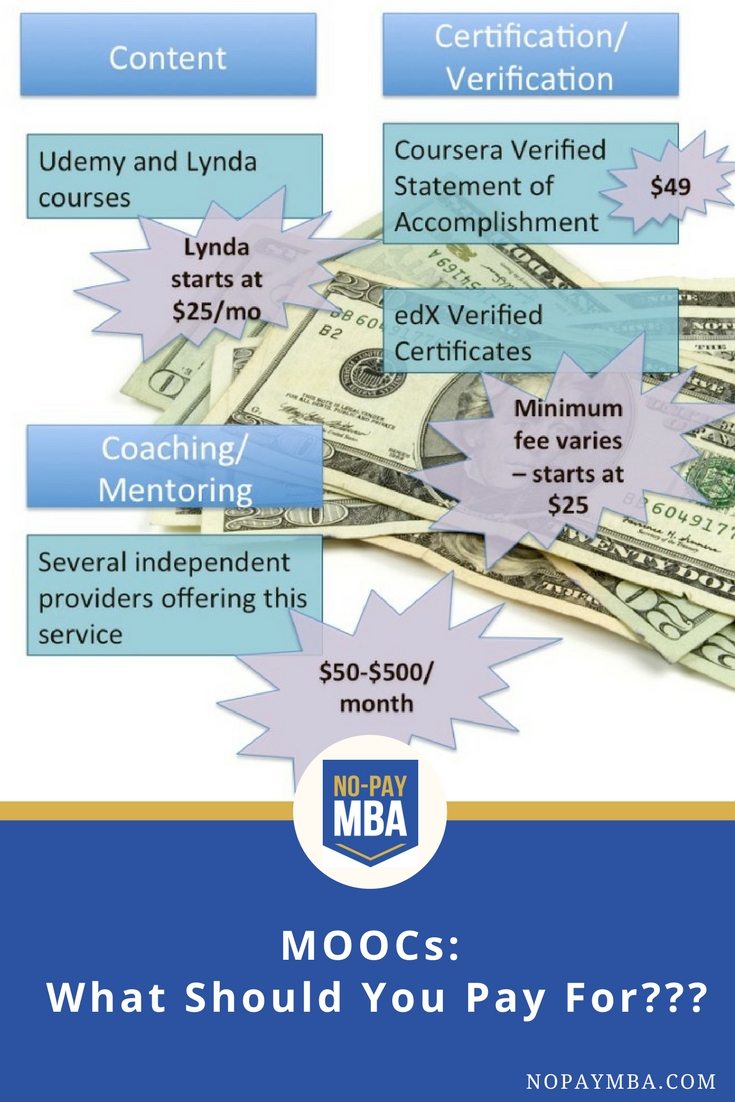
As the MOOC providers search for viable revenue models, the number of things you can pay for in the MOOC world has exploded. From subscription sites like Lynda, to micro-credentials like Udacity’s Nanodegrees and Coursera’s Specializations, the array of options is dizzying. None is as expensive as regular college credit, but fees for MOOCs now range from free with an option to pay $50 for a verified certificate (Coursera, edX), to upwards of $900 for a single course (NovoEd), to $200 per month for access to as many courses as you can handle (Udacity, Lynda).
In the early days of massive open online courses you couldn’t pay for a course or a certificate if you wanted to.
In my opinion, the proliferation of non-free options is a good thing; it is only by having sustainable business models that the MOOC platforms will be able to stay in existence and continue producing high-quality content.
But given that all of these products are new and unproven, as a MOOC student it can be confusing to sort through them.
What is your goal and how much can you afford?
Just over a year ago, an article about the No-Pay MBA went viral. The headline made reference to a figure of $1000, which was how much I planned to spend on my MOOC-based MBA equivalent. That original estimate of $1000 was actually what I planned to spend to build my website – including hosting, the price of the site itself, some help from people who know more about the internet than I, and other assorted fees associated with running a website. I had not at that time – and in fact I still haven’t – spent any money on courses themselves. To be precise, mine is not a $1000 education, but rather a free education with a $1000 website.
There are a lot more ways to spend $1000 on online learning now than there were a year ago, but the approach I would recommend hasn’t changed.
- First, get very clear about your goals.
- Second, determine how much money you can afford to spend to reach those goals.
- Finally, when deciding how to spend that money, look for those options that do some combination of the following:
- Give you access to specialized content
- Provide you the motivation to finish your courses
- Lend credibility to your studies
When I started this project, I didn’t need to pay for specialized content, since the content I needed was available for free. But I did need to find a way to bring credibility to my effort – and to stay motivated enough to see it through. Building a website was the best way to build credibility for online learning, and being accountable to my readers has been critical to maintaining the motivation I need to complete my courses.
Fortunately, you have many options when it comes to accessing specialized content, maintaining motivation, and building credibility. With those key principles in mind, here is my take on what you should pay for when it comes to online education.
Certificates and identity-verified certificates
What they are
Most MOOC platforms give certificates – free or paid – to indicate a student’s completion of a course. Coursera and edX also offer an identity-verified certificate to ensure that the student who holds the certificate is the person who did the work for the course.
How much they cost
Coursera and edX will give you a basic certificate for free. Future Learn and MiriadaX offer paid certificates (£29 and €40, respectively). Coursera’s identity-verified Statement of Accomplishment costs $49 per course. edX verified certificates are on a sliding scale, with prices typically starting at $25 or $50 per course.
Worth it?
If you need the extra motivation, yes. I’ve written a more detailed analysis of the value of identity-verified certificates, but when it comes to credibility, I don’t think these fancier certificates are worth the expense – unless paying for the certificate will give you the motivation you require to finish the course. Of course, you may want to support a non-profit like edX, or the course may be part of a longer series which requires identity-verification for the overall cert. Which brings me to the next option.
Micro-credentials
What they are
Series of courses packaged into sets. Udacity’s Nanodegrees are primarily for IT topics. Coursera has partnered with Wharton to offer a Business Foundations Specialization. edX offers a Specialization in Supply Chain Management.
How much they cost
Udacity charges $200 per month, so the more quickly you finish, the less you spend. Coursera charges $595 for its Business Foundations Specialization ($95 per identity-verified course certificate, plus $215 for a capstone project). edX charges $375 for the Supply Chain Management series.
Worth it?
A pretty good bet. Micro-credentials are still very new, but with employers now collaborating on their design, they are likely to look very good on a resume. Good enough to replace a degree? Not yet, but who knows what the future will bring.
Course content
What it is
Some sites require you to pay just to access their content. The most popular of these sites are Lynda, Udemy, and Udacity.
How much it costs
Varies significantly - $25 per month for a basic Lynda subscription, from $40 to $200 for most coursees on Udemy, $200 per month on Udacity.
Is it worth it?
Yes, if you can’t get the content for free somewhere else, and if you’ll use it consistently.
Mentorship/Coaching
What it is
Support from a tutor or coach as you work your way through the course content. Udacity offers limited coaching in its Nanodegrees. Sites like Thinkful and SlideRule specialize in coaching students through courses on coding and programming.
How much it costs
Part of the monthly fee on Udacity, SlideRule charges $400 per month, and Thinkful charges $500 per month. I offer more affordable packages, starting at $50 per month. You can learn more about No-Pay MBA coaching packages here.
Worth it?
Yes. Not many options exist yet for business students – this service is primarily geared towards IT courses – but having someone there to help you along is key to course completion, especially for difficult subjects.
